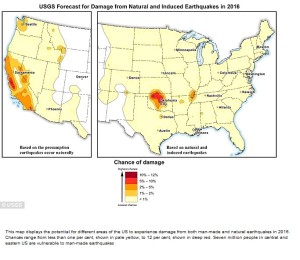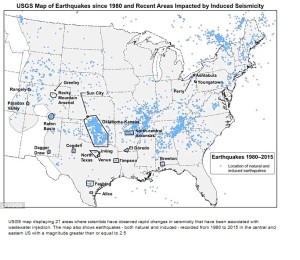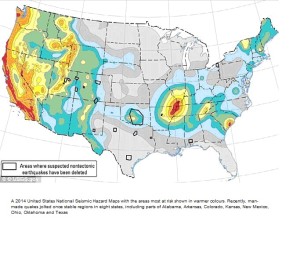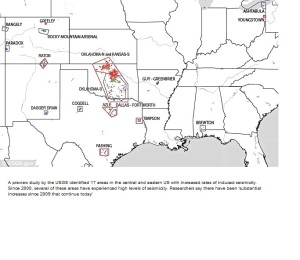Man-made earthquakes are a threat to 7 MILLION Americans: Map reveals how fracking has increased risk of US tremors
• Oklahoma is at greatest risk for hazards linked with man-made tremors
• It is followed by Kansas, Texas, Colorado, New Mexico and Arkansas
• Risk has increased dramatically, much of it due to drilling for energy
By ELLIE ZOLFAGHARIFARD FOR DAILYMAIL.COM
PUBLISHED: 13:10 EST, 28 March 2016 | UPDATED: 18:30 EST, 28 March 2016
Seven million people in central and eastern US are vulnerable to man-made earthquakes.
This is according to the first ever map of damaging quakes for this year, released today by the US Geological Survey.
The map shows how chance of damaging earthquakes hitting east of the Rockies has increased significantly, much of it a man-made byproduct of drilling for energy.
Scroll down for video
+4
These earthquakes were sometimes caused by fracking, in which large volumes of water, sand and chemicals are pumped into rock formations to free oil or gas.
Oklahoma now has a 1 in 8 chance of damaging quakes in 2016, surpassing California as the state with the highest probability.
Natural earthquake risk also increased around the New Madrid fault in Missouri, Tennessee, Kentucky, Arkansas and Illinois
As a result, earthquakes caused by human activity will now be included in the U.S. Geological Survey’s seismic risk maps.
‘By including human-induced events, our assessment of earthquake hazards has significantly increased in parts of the US,’ said Mark Petersen, Chief of the USGS National Seismic Hazard Mapping Project.
+4
+4
Oklahoma is at the greatest risk for hazards associated with induced seismicity, the USGS said, followed by Kansas, Texas, Colorado, New Mexico and Arkansas.
Oklahoma in 2015 experienced 907 magnitude-3.0 or greater earthquakes, compared with just two of similar size in 2009.
In February, a 5.1-magnitude temblor shook the area around Fairview, Oklahoma – the third strongest recorded in the state.
The uptick in quakes has prompted serious concern among locals, particularly those in close proximity to the oil storage hub at Cushing, Oklahoma, which is home to some 66 million barrels of oil and the delivery point for the widely-traded West Texas Intermediate futures contract.
‘We have had some earthquakes that were way to close to those tanks,’ said Michael Teague, Oklahoma’s Secretary of Energy and Environment.
HOW DOES WASTEWATER INJECTION CAUSE EARTHQUAKES?
The fluid pressure in the pores and fractures of the rocks is called the ‘pore pressure.’
The pore pressure acts against the weight of the rock and the forces holding the rock together.
If the pore pressures are low – especially compared to the forces holding the rock together – then only the imbalance of natural in situ earth stresses will cause an occasional earthquake.
If, however, pore pressures increase, then it would take less of an imbalance of in situ stresses to cause an earthquake.
This type of failure is called shear failure. Injecting fluids into the subsurface is one way of increasing the pore pressure and causing faults and fractures to ‘fail’ more easily.
Earthquakes can be caused by injecting fluid into the subsurface or by extracting fluids at a rate that causes subsidence and slippage along planes of weakness in the Earth.
Source: US Department of Energy
The disposal of saltwater – a natural byproduct of oil and gas drilling – into wells has been tied to earthquakes. Oklahoma regulators have already ordered many wastewater well companies to curb operations.
The USGS said building code committees are still determining whether to include induced earthquakes in their revisions, in part because they could be temporary.
The American Society of Civil Engineers is already in the process of publishing 2016 guidelines that do not take into account man-made earthquakes.
But the group does not anticipate updating those standards again until 2022.
‘There is always a delay in design codes adapting the USGS Seismic Hazard Maps,’ said Muralee Muraleetharan, a civil engineering professor at the University of Oklahoma.



